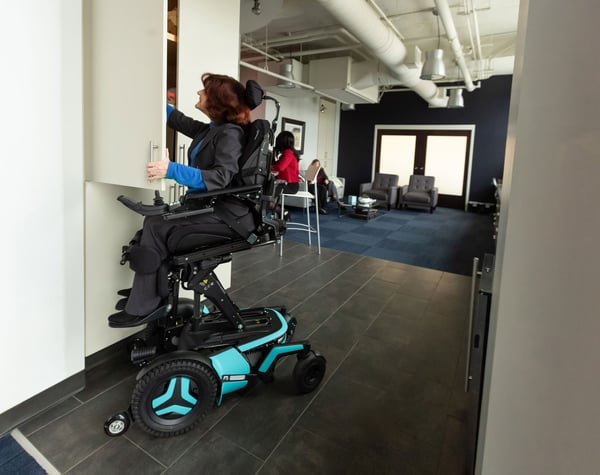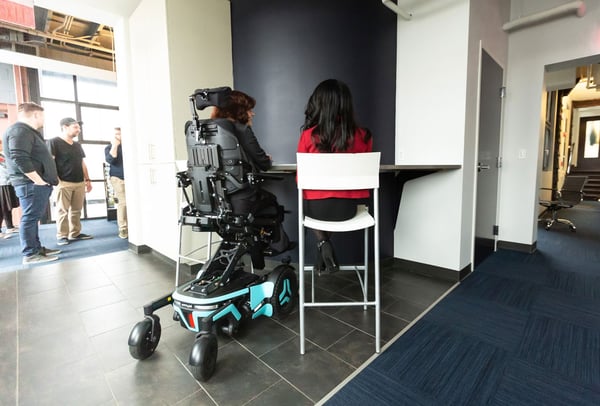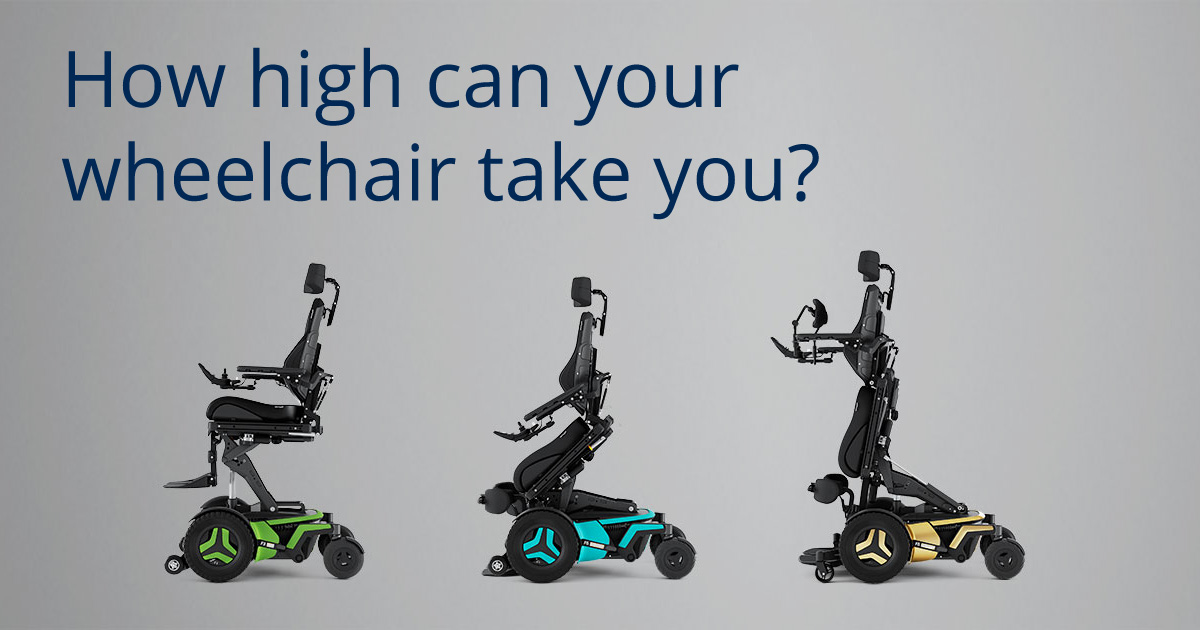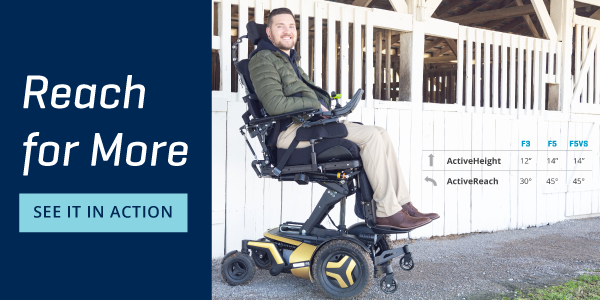Power seat elevation is a seat function available on power wheelchairs that may allow a person using this wheelchair to perform tasks and reach things that they might not otherwise be able to do from a typical seated height. Permobil has continued to improve the functional use of power seat elevation. Not only do we offer power seat elevation, called Active Height™, we offer anterior tilt called ActiveReach™. ActiveReach™ can create different experiences and interactions for wheelchair users as it brings them into a more functional position for daily tasks and allows the person to interact with their environment in a whole new capacity. This blog will highlight the tremendous advantages of ActiveHeight™ with ActiveReach™ and why this function should always be a consideration for appropriate power wheelchair users.
Safe Functionality
Power seat elevation is often utilized to provide improvement with functional reach. However, because of the footplate position interacting with the environment, it can be difficult to reach in a forward direction to obtain necessary items. For this reason, people often end up reaching sideways when elevated. A sideways reach increases the chance of shoulder injury due to weakened muscle force and possible muscle/tendon impingement. This can lead to early shoulder dysfunction and even muscle or tendon tears, both of which can result in a significant loss of function at the shoulder girdle.

ActiveHeight™ with ActiveReach™ allows you to reach from a forward position, improving your ability to view your task. Reaching from this position also maximizes use of available shoulder strength and range of motion and reduces the risk of shoulder injury. This may improve functional use of the arms and increase independence when performing daily activities.
- Improves functional reach
- Reduces risk of shoulder injury
- Maximizes use of available upper extremity strength
- Improves line of site when reaching for items
Safe Transfers
ActiveHeight™ with ActiveReach™ places the wheelchair into a forward tilt position, which may help you perform safer and more independent transfers. Use of ActiveHeight™ and ActiveReach™ increases overall seat height by lifting from the back of the seat decreasing the strength and effort required of the quadriceps to go from a seated position to standing. For individuals with a progressive condition, this feature may allow for the ability to perform a safe and independent transfer longer than one would be able to otherwise.
The anterior tilt provided by ActiveReach™ may also make it easier to scoot forward towards the edge of the seat to achieve an ideal “starting position” for a sit to stand or squat pivot transfer.
If a person is unable to independently perform transfers, use of the anterior tilt may reduce the amount of assistance a caregiver must provide. It may also result in a more ergonomic position for the caregiver during transfers and could therefore reduce the risk of caregiver injury and falls.
- Safer transfers with less effort
- Reduces amount of effort required of caregiver
- Eases scooting forward in preparation for transfer
- Help to take weight off the pelvis to place a transfer board
Improved Sitting Position
For some people, ActiveReach™ can have a positive effect on posture. In a seated position, the natural curves of the spinal column are often flattened due to the pelvis falling posteriorly. Sitting in a seat that is anteriorly tilted often results in the pelvis achieving a more neutral or slight anterior position within the person’s available range of positions. This can improve the natural curve in your lower back, lumbar lordosis, and facilitate extension in the thoracic spine. If a person is able to actively use their core muscles, this position may help activate these muscles. With the use of the anterior knee support, there is an additional point of contact for postural support. When the pelvis and trunk are stabilized and supported, functional reach and environmental access may be improved.
- May improve seated posture
- Maximizes use of available core strength
- Enhance stability of neutral spinal alignment
- Work environment enhanced
Improved Breathing and Digestion
In a prolonged seated position, intra-abdominal pressure is increased, constricting the chest and abdomen. As a result, the diaphragm may not contract effectively in some people, and deep breathing may be limited. This can result in shallow breathing, decreasing oxygenation throughout the body. It may also result in a reduced effective cough. A weak or absent active cough reduces the ability to evacuate mucus with bacteria from the upper respiratory tract. This can lead to respiratory infections or pneumonia.
A second result of a prolonged seated position is the decrease of peristaltic movement of the intestines. The transit time, or the time nutrients need to pass through the intestines, increases. A longer transit time in the colon increases the risk of constipation and impaction. Research has shown that food leaves the stomach much easier when individuals change position and is much more difficult when people stay in the same position for a long period of time.
ActiveReach™ may have a positive effect on breathing and digestion by allowing changes of position that promote an open angle at the hips and an open chest cavity. This can help to decrease intra-abdominal pressure to promote digestion and increased space for the diaphragm to contract effectively and allow for deep breathing.
- Provides change of hip angle during sitting
- Position to allow increased function of intestines
May assist in ribcage expansion to help take a deep breath
Reducing Spasticity and Managing Tone
Many people who use wheelchairs experience spasticity or changes in muscle tone. This causes an inefficient amount of energy expenditure, increased fatigue, pain and discomfort, and can often result in unwanted changes in position, and decreased function. A treatment technique which is often utilized by a treating clinician to manage spasticity, is weight bearing. In addition, a treatment recommendation may include passive range of motion, which may decrease the impact of prolonged spasticity on the muscles. The result of even minimal weight bearing has a periodic effect and needs to be repeated quite regularly, which can be achieved with the assistance of ActiveReach™. While mobility equipment is not a substitute for passive range of motion and additional recommended home exercises, the ability to change hip and knee angles with ActiveReach™ can accompany therapeutic goals within the range recommended by a clinician.
- Enhance therapy goals
- Promote reduction in spasticity
- Support existing range of motion
Improving Sight and Communication
People in a wheelchair often experience a decreased visual field and a change of their communication possibilities, especially in busy spaces. Because of the typical height when in seated position, people may experience tension in their neck musculature while maintaining eye contact with people of varying heights. Many people also have to raise their speech volume, which is often not possible because of the impaired breathing function, because of the distance from the conversation partner. A person who uses a wheelchair may also be approached differently because they are in a lower seated position, which can have a negative influence on their self-esteem and confidence.

The use of ActiveHeight™ with ActiveReach™ lifts a person higher and closer towards a conversation partner and increases their visual field at the same time. The head and neck can be held in a more neutral position, decreasing the risk of neck pain. Active engagement and communication become easier and facilitate a more natural and less tiresome communication.
- Increase interaction
- Improve speech production
- Enhance engagement in activities
With all the potential benefits, both medical and functional, consider ActiveHeight™ and ActiveReach™ for power wheelchair users!
 Stacey Mullis, OTR/ATP
Stacey Mullis, OTR/ATP
Director of Clinical Marketing
Stacey serves as Director of Clinical Marketing for Permobil. A practicing OTR for over 20 years, she has experience in school-based pediatrics, inpatient rehabilitation, long term care, and home health. With her interest in wheelchair seating and positioning, Stacey engaged the challenges of providing appropriate seating in various clinical settings. She now uses this experience to develop programs and resources to educate clinicians on the principles of seating and wheeled mobility. She is passionate about equipping clinicians and through her previous role as Director of Clinical Education with Comfort Company and now with Permobil she has taught nationally and internationally to increase therapist capacity in this specialty area. Mullis graduated from Western University in London, Ontario, Canada with a BA Linguistics and BSc Occupational Therapy. She is a member of the NCOTA, CTF Executive Board, NRRTs, RESNA, and AOTA.
 Jennith Bernstein, PT, DPT, ATP/SMS
Jennith Bernstein, PT, DPT, ATP/SMS
Regional Clinical Education Manager
Jennith Bernstein received her masters in Physical Therapy at North Georgia College & State University and returned to complete her transitional DPT at University of Texas Medical Branch in 2014. While at Shepherd Center, Jennith, initiated a “Seating Champion” program to improve the inpatient and day program clinicians understanding of complex seating, pressure management and skin protection as well as research reviews, advanced programming and adjustments. She was also part of a center wide multidisciplinary focus group for reduction of hospital acquired skin breakdown. Jennith has served as a volunteer teacher at the Universidad Mariano Galvez in Guatemala, instructing spinal cord injury curriculum as well as seating and mobility. Jennith has presented at national conferences such as RESNA, ISS, and the APTA NEXT conference. Jennith has been a practicing PT for 12 years and spent the last 10 years at a model SCI center (Shepherd Center) in Atlanta, Georgia. Jennith joined Permobil as the Clinical Education Manager for the Central Region in 2016.

